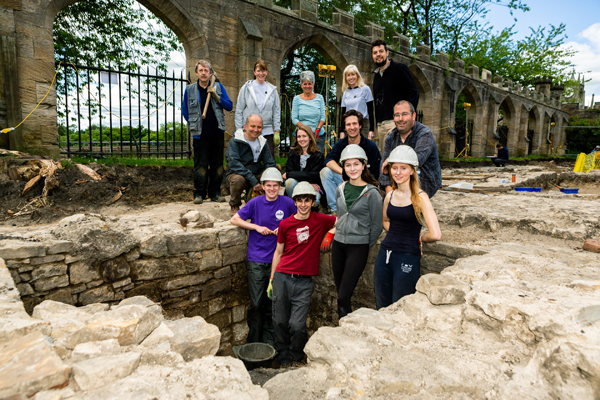Medieval mysteries, hidden beneath the grounds of a 900-year-old County Durham castle, have been uncovered during a major archaeological excavation.
More than 90 archaeologists, students and volunteers from Durham University and The Auckland Project have spent the past month peeling back the centuries at Auckland Castle, Bishop Auckland as part of the latest excavation at the former home of the powerful Prince Bishops of Durham.
Key discoveries include the location of the original medieval chapel, which has remained a mystery for centuries, a 13th century kitchen and the remains of what is believed to be the oldest defensive building unearthed at the Castle to date.
The excavations took place as Auckland Castle undergoes a major programme of conservation, supported thanks to National Lottery players via the Heritage Lottery Fund (HLF).
In the course of the excavation, the foundation of the chapel’s southern wall was revealed, with the rest of the building believed to be buried beneath the Castle’s existing Bishop’s study. When unearthed, the chapel’s foundation pillar stones were found split in two, suggesting Hazelrigg may even have used explosives to demolish it.
It is believed that this would have served as a clear demonstration of the wealth and power of the medieval Prince Bishops of Durham.
Archaeologists working around the site of Auckland Castle’s medieval Great Hall, which has served as St Peter’s Chapel since its conversion in the 17th century, also uncovered remains of a 13th century kitchen with two hearths, which would have served the Bishop’s guests.
The final days of the dig also brought a unique discovery, preserved timber from what might be a wooden tank used in the malting process for beer making. The discovery of preserved wood is rare and timber samples will be sent for further laboratory analysis to reveal the age of the tank.
And smaller artefacts such as thimbles, hawking whistles and sword pommels have also been unearthed, offering a glimpse into the day-to-day lives of those living in Auckland Castle in the medieval period.
The archaeological excavation, which ran from 4-23 June, is the first in a new series of annual digs to be run by The Auckland Project and Durham University, with archaeologists set to return in 2019 and 2020 to continue their research into the early life of Auckland Castle.
The archaeological excavation took place as Auckland Castle undergoes a multi-million pound programme of conservation to return the property to its former Georgian Gothic splendour, as designed by renowned English architect James Wyatt, (1746 – 1813).
The conservation of Auckland Castle is also supported by the Heritage Conservation Trust, Sir James Knott Trust, The Charles Hayward Foundation, The Headley Trust, The Linbury Trust, The Rothschild Foundation, Garfield Weston Foundation, J Paul Getty Jnr Charitable Trust and Richard Oldfield.
For more information on the discoveries made at Auckland Castle visit the Durham University Auckland Castle Excavation blog at https://duaceblog.wixsite.com/2018.
To stay up to date with The Auckland Project visit, aucklandproject.org, sign up to The Auckland Project’s monthly newsletter or follow The Auckland Project on social media.

